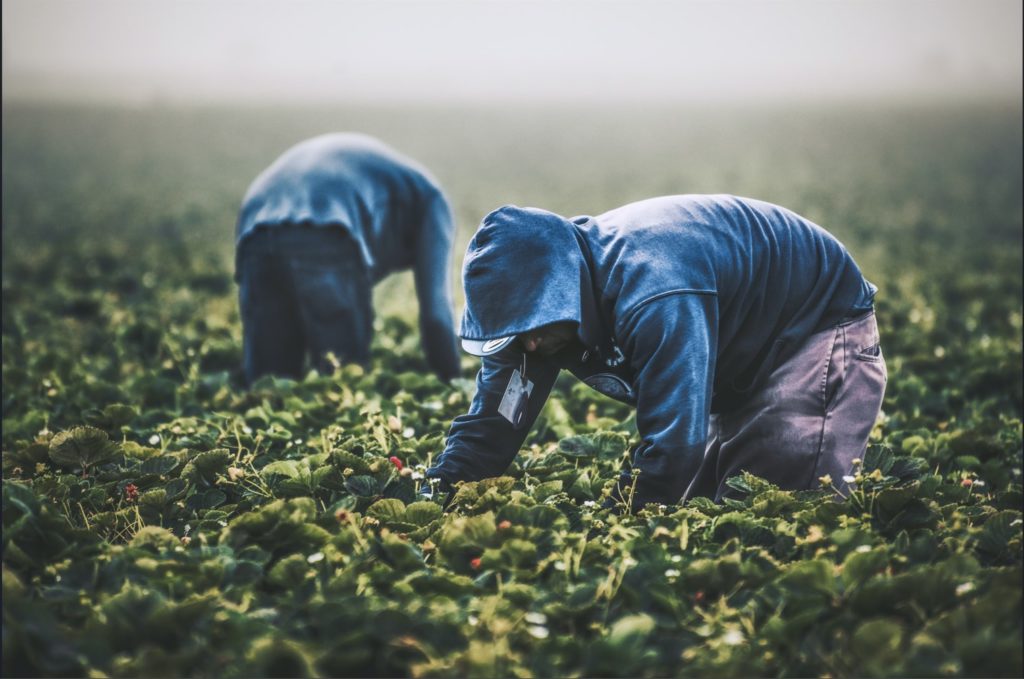
The healthcare system in the United States boasts some of the most cutting-edge technology and research, but this high quality of care is not evenly distributed. For minorities, such as Latinos living in rural areas, their health is controlled by social, economic, and political determinants. We have studied these social determinants of health in class, and learned that determinants are:
“The conditions in the environments where people are born, live, learn, work, play, worship, and age that affect a wide range of health, functioning, and quality of life outcomes and risks.”
Healthy People 20302
While I agree that the facts and statistics about the number of people affected are important to know, I would like to share a couple of stories that show the people hidden between all those numbers. I was reminded of them after having read the Nature article by Amy Maxmen which discussed how farm worker disparities are due to their social determinants of health.3
Working at a berry farm for three years was a wonderful opportunity because I got to learn about agriculture and work alongside 200+ workers from Mexico in order to harvest over 400 acres of strawberries, blueberries, blackberries, peaches, and muscadines. The work was not for the faint of heart because it required seven days work weeks in blistering humid Arkansas heat and resulted in millions of pounds of produce each season. This became even more challenging when the company limited workers’ contact with the outside world in an attempt to reduce the chances of the Corona virus running rampant in the small rooms that housed anywhere from six to fifteen people. It was amidst all the craziness that comes with harvesting crops, that I got to know some of the workers such as Rosita and Jose and realized just how many adversities they must overcome in order to receive medical care.

Rosita, The Spokeswoman
If you ever need someone to control a group of over 200 rowdy adults with one word, Rosita is the one you call. She was the unofficial spokeswoman for all the workers and was the first to voice everyone’s concerns about the COVID vaccine when it was offered at the farm. All they were told was that if any worker wished they to receive the vaccine they could do so for free. This news though exciting for some was also troublesome for others because they wanted some more information before making a decision. A week before the vaccine was to be administered, I was tasked with asking everyone whether or not they wished to receive the vaccine but was warned by my supervisor to not offer my opinion or answer questions because I was not a medical professional and could be held liable if something were to happen. Rosita was the first to bombard me with questions, but at that time, all I was able to share was that physicians are required to inform a patient of any possible side effects and must sign an informed consent form.5 The only problem with that is that the doctor had sent said forms, but they were in English. It took a lot of research and persuasion before the company agreed to prepare a meeting in which a doctor would address the workers’ concerns and hand out a Spanish version of the possible side effects.
Rosita’s story is just one of millions that highlight how language, education access, and socioeconomic status play a role in a person’s health. There are many Non-English speaking migrants that are not comfortable going to the doctor out of fear that the appointment or medication may be too expensive or based on previous frustrations from trying to communicate with the doctor. Many Latinos who do not speak English are less likely to receive medical care6 or are less informed of the medical situation due to the language barrier.7

Jose, The Veteran
By my second year, I had become the farm medic and would treat any minor injuries or acquire medication during the first year when the farm was on lockdown. I would often help the workers before or after their shift, so it wasn’t surprising that Don Jose, a man who has been working at the farm for over twenty years, was there to greet me at six thirty in the morning as I opened up the store for the day. Cuts, scrapes, and bruises are common occurrences at a farm, but when Jose began to limp into the store to ask for pain medication, I knew that the situation was more serious than he was letting on. It took a lot of convincing and promises that he would not have to miss work before he finally explained that he had hit his leg had hit a nail on the edge of a trailer when he was loading boxes of fruit, and when he finally showed me his shin, I informed my manager of the situation. During his lunch break, he was taken to a clinic an hour away where the doctor informed the other farm interpreter that the wound on his shin had become infected and would need to be cleaned daily for two weeks before asking he schedule a follow up appointment. He was told to rest his leg for three days and keep it elevated to reduce the swelling, but Jose went back to work the next day after I disinfected his wound. He continued to work with his injured leg until the end of that harvesting season where he returned to Mexico to treat his wound.
Aside from the vulnerability due to language barriers and lack of access to education, farm workers also face physical, political, and economical barriers that prevent them from seeking adequate care. Many might wonder why Jose didn’t just inform someone of his injury immediately after it occurred. The reason for that is out of fear that his injury would put him out of work and cost him a lot of money to get it looked at. In the agriculture business, migrant workers are supposed to be paid a flat hourly rate and a piece rate pay, but there are many owners who violate these wage laws or decide to return the worker to their country if they are not picking quick enough.9 Farm owners are also not required to provide healthcare insurance for their workers because they are seasonal employees. All of these circumstances drive many workers like Jose to work through injuries instead of seeking medical care.10
Conclusion
Although I focused on the social determinants of health of two people and how their categories affected their healthcare outcomes, these determinants apply to everyone’s life. Research continues to show us the relation between the social determinants and the disparities in healthcare for minority groups such as Latinos. These disparities were especially brought under scrutiny during the COVID pandemic, but now having acknowledged that they exist, it is time to start work to eliminate these disparities and make healthcare more accessible for everyone. I know that when those changes do come, they will be because of people like Rosita and Jose, not because of some statistics we read somewhere.
Works Cited
1Mossholder, Tim. “Strawberry Picking.” Unsplash, 21 July 2021, https://unsplash.com/photos/Kx060cRsmt0.
2“Healthy People 2030,” U.S. Department of Health and Human Services, Office of Disease Prevention and Health Promotion, https://health.gov/healthypeople/objectives-and-data/social-determinants-health
3Maxmen, Amy. “Inequality’s Deadly Toll.” Nature News, Nature Publishing Group, 28 Apr. 2021, https://www.nature.com/immersive/d41586-021-00943-x/index.html
4 Chena, Lucero. “Lake and Blackberry Field View.” 6 June 2020.
5 Commissioner. “Pfizer-BioNTech Covid-19 Vaccines.” U.S. Food and Drug Administration, FDA, https://www.fda.gov/emergency-preparedness-and-response/coronavirus-disease-2019-covid-19/pfizer-biontech-covid-19-vaccines.
6Taira, D A. “Improving the Health and Health Care of Non-English-Speaking Patients.” Journal of General Internal Medicine, U.S. National Library of Medicine, May 1999, https://www.ncbi.nlm.nih.gov/pmc/articles/PMC1496581/#:~:text=Non%2DEnglish%2Dspeaking%20patients%20receive,care%20than%20English%2Dspeaking%20patients.
7Al Shamsi, Hilal, et al. “Implications of Language Barriers for Healthcare: A Systematic Review.” Oman Medical Journal, U.S. National Library of Medicine, 30 Apr. 2020, https://www.ncbi.nlm.nih.gov/pmc/articles/PMC7201401/#:~:text=Other%20studies%20found%20that%20among,a%20problem%20understanding%20their%20healthcare.
8 Chena, Lucero. “Gazebo Over Lake.” 6 June 2020.
9 Robinson, Erin, et al. “Wages, Wage Violations, and Pesticide Safety Experienced by Migrant Farmworkers in North Carolina.” New Solutions: a Journal of Environmental and Occupational Health Policy : NS, U.S. National Library of Medicine, 2011, https://www.ncbi.nlm.nih.gov/pmc/articles/PMC3291018/.
10Bail, Kari M., et al. “The Impact of Invisibility on the Health of Migrant Farmworkers in the Southeastern United States: A Case Study from Georgia.” Nursing Research and Practice, Hindawi, 1 July 2012, https://www.hindawi.com/journals/nrp/2012/760418/.
